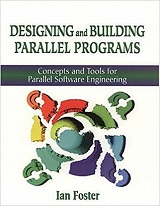
|
FreeComputerBooks.com
Links to Free Computer, Mathematics, Technical Books all over the World
|
|
- Title: Designing and Building Parallel Programs: Concepts and Tools for Parallel Software Engineering
- Author(s) Ian Foster
- Publisher: Pearson; 1st edition (May 24, 2019)
- Paperback: 408 pages
- eBook: HTML and PDF
- Language: English
- ISBN-10: 0201575949
- ISBN-13: 978-0201575941
- Share This:

|
This book introduces the parallel paradigm, and shows how parallel programming is carried out using a variety of programming languages. Foster details actual applications examples from engineering, science, and finance while keeping the focus throughout on parallel programming as opposed to algorithm development.
At last, a practitioner's guide to parallel programming! Students and professionals who use parallel or distributed computer systems will be able to solve real problems with Designing and Building Parallel Programs.
This book provides a comprehensive introduction to parallel algorithm design, performance analysis, and program construction. It describes the tools needed to write parallel programs and provides numerous examples.
A unique feature is the companion on-line version, accessible via the World Wide Web using browsers such as Mosaic. This provides a convenient hypertext version of the text with pointers to programming tools, example programs, and other resources on parallel and distributed computing.
About the Authors- Ian Foster is a New Zealand-American computer scientist. He is a distinguished fellow, senior scientist, and director of the Data Science and Learning division at Argonne National Laboratory, and a professor in the department of computer science at the University of Chicago.
- Parallel Computing and Programming
- Algorithms and Data Structures
- Computational Complexity
- Computational and Algorithmic Mathematics

- Designing and Building Parallel Programs (Ian Foster)
- The Mirror Site (1) - HTML
- The Mirror Site (2) - PDF
-
 Introduction to Parallel Computing (Blaise Barney)
Introduction to Parallel Computing (Blaise Barney)
This book explains how to design, debug, and evaluate the performance of distributed and shared-memory programs. It teaches students how to compile, run and modify example programs. It is a complete end-to-end source of information on all aspects.
-
 Is Parallel Programming Hard? If So, What Can You Do About It?
Is Parallel Programming Hard? If So, What Can You Do About It?
It examines what makes parallel programming hard, and describes design techniques that can help you avoid many parallel-programming pitfalls. It is primarily intended for low-level C/C++ code, but offers valuable lessons for other environments as well.
-
 The Practice of Parallel Programming (Sergey A. Babkin)
The Practice of Parallel Programming (Sergey A. Babkin)
This book provides an advanced guide to the issues of the parallel and multithreaded programming. It goes beyond the high-level design of the applications, into the details that are often overlooked but vital to make the programs work.
-
 Parallel Programming with CUDA: Architecture, Analysis, Application
Parallel Programming with CUDA: Architecture, Analysis, Application
This book offers a detailed guide to CUDA with a grounding in parallel fundamentals. With CUDA, you can use a desktop PC for work that would have previously required a large cluster of PCs or access to a High-Performance Computing (HPC) facility.
-
 Parallel Programming in MPI and OpenMP (Victor Eijkhout)
Parallel Programming in MPI and OpenMP (Victor Eijkhout)
This is a textbook about parallel programming of scientific application on large computers, learn how to design, analyze, implement, and benchmark parallel programs in C/C++ and Fortran using Message Passing Interface (MPI) and/or OpenMP.
-
 Programming on Parallel Machines: GPU, Multicore, Clusters, etc.
Programming on Parallel Machines: GPU, Multicore, Clusters, etc.
The main goal of the book is to present parallel programming techniques that can be used in many situations for many application areas and which enable the reader to develop correct and efficient parallel programs.
-
 Parallel Algorithms (Henri Casanova, et al)
Parallel Algorithms (Henri Casanova, et al)
Focusing on algorithms for distributed-memory parallel architectures, the book extracts fundamental ideas and algorithmic principles from the mass of parallel algorithm expertise and practical implementations developed over the last few decades.





